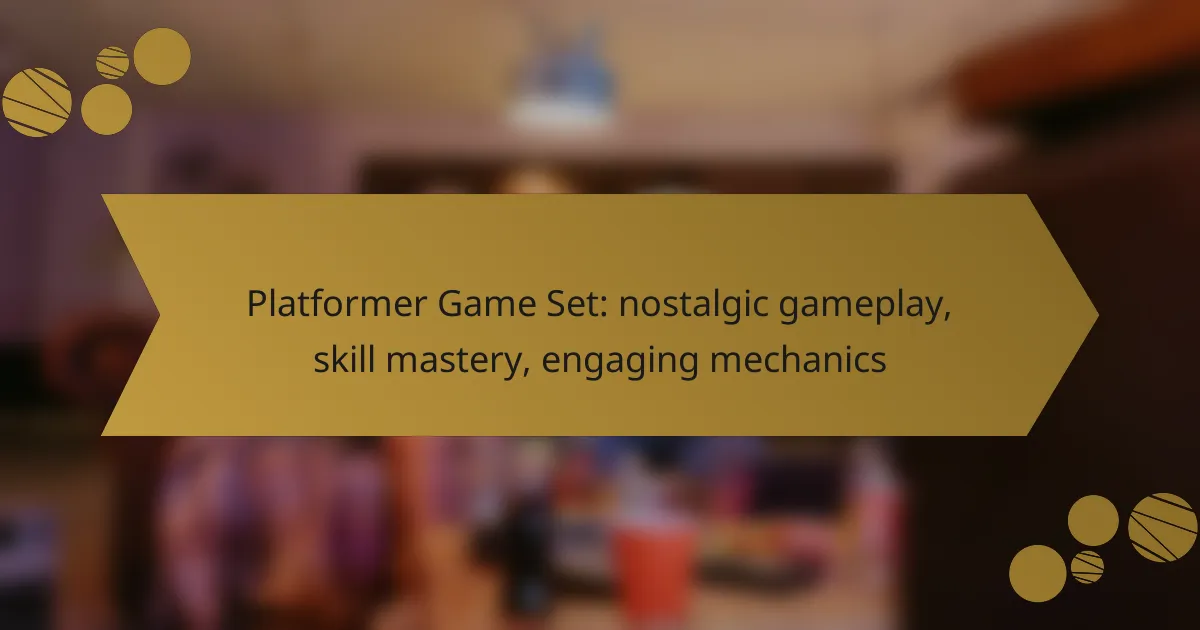Platformer games that evoke nostalgia blend classic gameplay with innovative design, creating an experience that resonates with both veteran players and newcomers. Titles such as Super Mario Odyssey and Celeste challenge players to master their skills through intricate level designs and engaging mechanics, ensuring hours of fun and satisfaction. With a focus on precise control and strategic thinking, these games offer a rewarding journey through vibrant worlds filled with collectibles and power-ups.

What are the best platformer games for nostalgic gameplay?
The best platformer games for nostalgic gameplay combine classic mechanics with modern design elements, evoking fond memories while providing fresh challenges. Titles like Super Mario Odyssey, Celeste, and Shovel Knight stand out for their engaging gameplay and skill mastery, appealing to both seasoned gamers and newcomers alike.
Super Mario Odyssey
Super Mario Odyssey is a quintessential platformer that captures the essence of classic Mario games while introducing innovative mechanics. Players explore diverse worlds, utilizing Mario’s cap, Cappy, to possess enemies and objects, adding layers of strategy and creativity to gameplay.
The game features a mix of open-world exploration and traditional level design, allowing players to tackle challenges in various ways. Collecting Power Moons encourages exploration, and the game’s vibrant art style and catchy soundtrack enhance the nostalgic experience.
Celeste
Celeste is a modern platformer that pays homage to classic titles while offering a deeply emotional narrative. Players control Madeline as she climbs the titular mountain, facing challenges that test both reflexes and problem-solving skills.
The game is known for its precise controls and challenging levels, making skill mastery essential. With its retro-inspired graphics and a soundtrack that complements the gameplay, Celeste evokes nostalgia while delivering a fresh and heartfelt experience.
Shovel Knight
Shovel Knight blends retro aesthetics with modern gameplay, reminiscent of 8-bit classics. Players take on the role of the titular knight, using a shovel as both a weapon and a tool for exploration, which adds a unique twist to the platforming genre.
The game features tight controls and a variety of levels filled with secrets and collectibles. Its charming pixel art and engaging story, along with memorable boss battles, create a nostalgic yet innovative experience that resonates with fans of classic platformers.

How do platformer games enhance skill mastery?
Platformer games enhance skill mastery by requiring players to develop precise control and timing through engaging gameplay mechanics. Players must navigate complex levels, mastering various skills to progress and achieve higher scores.
Precision jumping mechanics
Precision jumping mechanics are central to platformer games, demanding accurate timing and positioning. Players often face challenges where they must leap between platforms with varying distances, heights, and moving elements. Mastering these mechanics can significantly improve a player’s overall skill level.
To excel, players should practice jumping techniques such as short hops, long jumps, and wall jumps. Understanding the physics of the game, including momentum and gravity, can help players make more informed decisions during gameplay.
Timing and reflex challenges
Timing and reflex challenges are crucial in platformers, as players must react quickly to obstacles and enemies. Many games feature sequences where players must jump or dodge at precise moments to avoid hazards or collect items. This aspect of gameplay trains players to improve their hand-eye coordination and reaction times.
To enhance timing skills, players can focus on rhythm and patterns in the game. Observing enemy movements and practicing difficult sections repeatedly can lead to better performance. It’s also helpful to stay calm under pressure, as panicking can lead to mistakes.

What engaging mechanics define modern platformer games?
Engaging mechanics in modern platformer games include dynamic level design and the use of power-ups and collectibles. These elements enhance gameplay by providing players with challenges that require skill mastery and strategic thinking.
Dynamic level design
Dynamic level design refers to environments that change in response to player actions or progress. This can include moving platforms, shifting obstacles, and interactive elements that create a sense of unpredictability and excitement. Levels may also feature multiple paths, encouraging exploration and replayability.
For instance, a level might transform as players collect certain items, unlocking new areas or altering the terrain. This design keeps players engaged and challenges them to adapt their strategies. Consider implementing checkpoints and varied difficulty levels to cater to different skill sets.
Power-ups and collectibles
Power-ups and collectibles are essential mechanics that enhance gameplay by providing temporary advantages or rewards. Power-ups can grant abilities like increased speed, invincibility, or enhanced jumping, allowing players to overcome obstacles more easily. Collectibles, such as coins or gems, often serve as incentives for exploration and can unlock additional content.
Designing a balanced system of power-ups is crucial; they should feel rewarding but not overpowering. For example, a well-placed power-up can help players navigate a difficult section without making the game too easy. Ensure that collectibles are strategically placed to encourage players to explore every corner of the level.

What are the key features of platformer game sets?
Key features of platformer game sets include engaging mechanics, a variety of character abilities, and multiplayer options that enhance gameplay. These elements contribute to a nostalgic experience while allowing players to master skills and enjoy dynamic interactions.
Variety of character abilities
Platformer games often feature a diverse range of character abilities that enhance gameplay and strategy. Players can choose characters with unique skills, such as double jumping, wall climbing, or speed boosts, which can affect how they navigate levels.
When selecting a character, consider how their abilities complement your playstyle. For instance, a character with a strong jump may be ideal for reaching high platforms, while one with speed can help in timed challenges. Experimenting with different characters can reveal new strategies and make gameplay more enjoyable.
Multiplayer options
Multiplayer options in platformer games can significantly enhance the experience by allowing players to collaborate or compete. Many games offer local co-op modes, where friends can play together on the same screen, or online multiplayer, enabling players to connect globally.
When engaging in multiplayer, consider the dynamics of teamwork versus competition. Cooperative gameplay often requires players to coordinate their abilities to overcome obstacles, while competitive modes can add excitement through races or challenges. Look for games that balance these elements to maximize fun and engagement.

How do platformer games compare across different platforms?
Platformer games vary significantly across platforms in terms of performance, controls, and user experience. Each platform offers unique advantages and challenges that can affect gameplay and player engagement.
PC vs Console performance
PC platformer games typically benefit from superior graphics and faster load times compared to consoles. High-end PCs can achieve frame rates in the high hundreds, while consoles generally operate within a range of 30 to 60 frames per second, depending on the title and hardware.
Additionally, PC gamers can customize settings for optimal performance, including resolution and graphical details. However, this flexibility requires a level of technical knowledge that may not be necessary for console users, who often enjoy a more streamlined experience.
Mobile adaptations
Mobile adaptations of platformer games often prioritize touch controls, which can impact precision and responsiveness. While many mobile games successfully replicate the platforming experience, the lack of physical buttons can make complex maneuvers more challenging.
Despite these limitations, mobile platformers can offer unique features, such as tilt controls or augmented reality elements, enhancing engagement. Players should consider the trade-offs between convenience and control when choosing to play platformers on mobile devices.

What are the prerequisites for developing a platformer game?
Developing a platformer game requires a solid understanding of game mechanics and familiarity with game engines. These elements are crucial for creating engaging gameplay that challenges players while providing a nostalgic experience.
Understanding game mechanics
Game mechanics are the rules and systems that govern how players interact with the game. In platformers, this includes character movement, jumping physics, and collision detection. Mastering these mechanics is essential for creating a fluid and enjoyable gameplay experience.
Consider incorporating various elements such as power-ups, enemy behaviors, and level design to enhance player engagement. For instance, introducing timed jumps or moving platforms can add layers of complexity and excitement.
Familiarity with game engines
Choosing the right game engine is vital for developing a platformer game. Popular engines like Unity and Unreal Engine offer robust tools for creating 2D and 3D platformers, each with its own strengths and learning curves. Unity, for example, is well-suited for 2D games and has a vast community for support.
When selecting an engine, consider factors such as ease of use, available resources, and compatibility with your target platforms. Familiarizing yourself with the engine’s features can significantly streamline the development process and help you avoid common pitfalls like performance issues or bugs.

What are the emerging trends in platformer games?
Emerging trends in platformer games focus on enhancing player engagement through innovative technologies and community involvement. Key developments include the integration of VR experiences, cross-platform play, and community-driven content creation, all of which aim to enrich gameplay and foster a more connected gaming environment.
Integration of VR experiences
The integration of virtual reality (VR) experiences in platformer games allows players to immerse themselves in vibrant, interactive worlds. This technology enhances the sense of presence, making players feel as though they are part of the game environment.
Developers are creating VR platformers that utilize motion controls for jumping, climbing, and dodging, which can significantly increase the physical engagement of players. Titles like “Astro Bot Rescue Mission” demonstrate how VR can transform traditional platforming mechanics into a more dynamic experience.
Cross-platform play
Cross-platform play is becoming a standard feature in platformer games, enabling players on different devices to play together. This trend broadens the player base and enhances community interaction, as friends can join in regardless of their gaming platform.
Games like “Celeste” and “Super Bomberman R Online” showcase successful implementations of cross-platform functionality, allowing seamless gameplay across consoles and PCs. Developers should consider this feature to increase accessibility and foster a more inclusive gaming community.
Community-driven content creation
Community-driven content creation empowers players to design and share their own levels and challenges within platformer games. This trend not only extends the lifespan of a game but also encourages creativity and collaboration among players.
Platforms like “Super Mario Maker” exemplify this trend, allowing users to create intricate levels that can be shared globally. Developers should facilitate tools for easy content creation and sharing, as this can lead to a vibrant ecosystem of user-generated content that keeps the community engaged.


